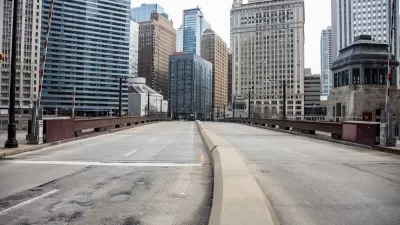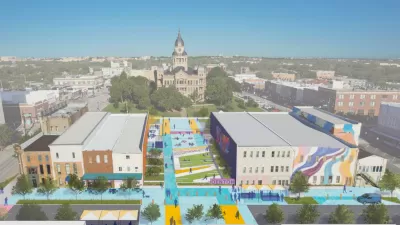Traditionally car-friendly Business Improvement Districts are turning to walkability and bike infrastructure to replace the 9-to-5 crowd and boost local economies.

In a piece for Bloomberg CityLab, John Surico describes the historically car-oriented politics of Business Improvement Districts (BIDs), business groups that emerged in the 1970s as a response to declining downtown conditions. “Historically, BIDs also typically favored access for cars, prioritizing suburban commuters and visitors with amenities like parking discounts and public lots. Indeed, the built environment of the American downtown — a ‘precarious urban monoculture’ optimized for white-collar work — is one that these groups helped cement into being.”
Now, “it’s striking to see the same groups now bang the gong for bike lanes, vehicle bans and pedestrian-focused facelifts. Reeling from the rise of remote work and the ongoing effects of the Covid pandemic, business groups are embracing policies and practices they long shunned.”
While not all BIDs are changing their views, many in the country’s biggest cities are recognizing the value of pedestrian and bicycle traffic and reorienting their efforts to new downtown residents and visitors in the post-pandemic era. “The paradigm shift that’s now underway could pay big dividends for walkability boosters — and be crucial to the survival of the urban core.”
“It took decades to create the modern office district; now that its critical vulnerabilities have been exposed, adapting these neighborhoods to again welcome a more diverse set of uses stands to be a similarly prolonged process.” Surico points out that BIDs, with their significant influence and resources, can be a key partner in creating more livable, walkable downtowns.
FULL STORY: As Downtowns Struggle, Businesses Learn to Love Bike Lanes

Alabama: Trump Terminates Settlements for Black Communities Harmed By Raw Sewage
Trump deemed the landmark civil rights agreement “illegal DEI and environmental justice policy.”

Planetizen Federal Action Tracker
A weekly monitor of how Trump’s orders and actions are impacting planners and planning in America.

How Atlanta Built 7,000 Housing Units in 3 Years
The city’s comprehensive, neighborhood-focused housing strategy focuses on identifying properties and land that can be repurposed for housing and encouraging development in underserved neighborhoods.

In Both Crashes and Crime, Public Transportation is Far Safer than Driving
Contrary to popular assumptions, public transportation has far lower crash and crime rates than automobile travel. For safer communities, improve and encourage transit travel.

Report: Zoning Reforms Should Complement Nashville’s Ambitious Transit Plan
Without reform, restrictive zoning codes will limit the impact of the city’s planned transit expansion and could exclude some of the residents who depend on transit the most.

Judge Orders Release of Frozen IRA, IIJA Funding
The decision is a victory for environmental groups who charged that freezing funds for critical infrastructure and disaster response programs caused “real and irreparable harm” to communities.
Urban Design for Planners 1: Software Tools
This six-course series explores essential urban design concepts using open source software and equips planners with the tools they need to participate fully in the urban design process.
Planning for Universal Design
Learn the tools for implementing Universal Design in planning regulations.
Jessamine County Fiscal Court
Caltrans
Institute for Housing and Urban Development Studies (IHS)
City of Grandview
Harvard GSD Executive Education
Toledo-Lucas County Plan Commissions
Salt Lake City
NYU Wagner Graduate School of Public Service





























